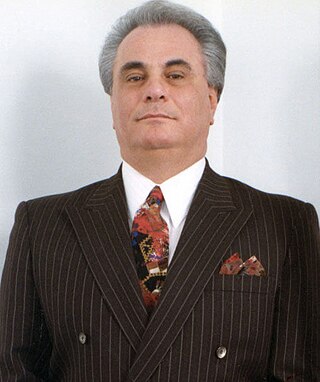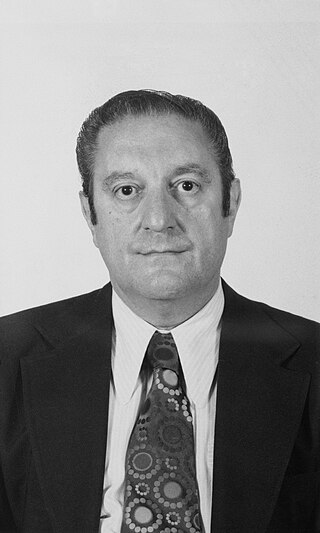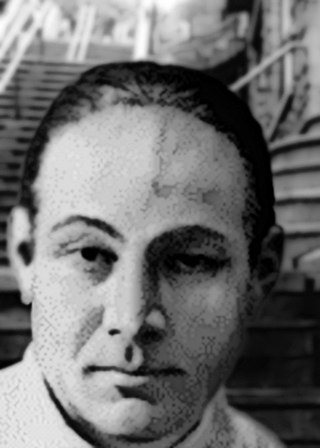Related Research Articles

John Gotti was an American mafioso and boss of the Gambino crime family in New York City. He ordered and helped to orchestrate the murder of Gambino boss Paul Castellano in December 1985 and took over the family shortly thereafter, leading what was described as America's most powerful crime syndicate.

Constantino Paul Castellano was an American crime boss who succeeded Carlo Gambino as head of the Gambino crime family of New York City. Castellano ran the organization from 1976 until his murder on December 16, 1985.

Salvatore Maranzano, nicknamed Little Caesar, was an Italian-American mobster from the town of Castellammare del Golfo, Sicily, and an early Cosa Nostra boss who led what later would become the Bonanno crime family in New York City. He instigated the Castellammarese War in 1930 to seize control of the American Mafia, winning the war after the murder of rival faction head Joe Masseria in April 1931. He then briefly became the Mafia's capo di tutti capi and formed the Five Families in New York City but was murdered on September 10, 1931, on the orders of Charles "Lucky" Luciano, who established The Commission, in which families shared power to prevent future turf wars.

Vincent Louis Gigante, also known as "Chin", was an American mobster who was boss of the Genovese crime family in New York City from 1981 to 2005. Gigante started out as a professional boxer who fought in 25 matches between 1944 and 1947. He then started working as a Mafia enforcer for what was then the Luciano crime family, forerunner of the Genovese family. Gigante was one of five brothers. Three of them, Mario, Pasquale, and Ralph, followed him into the Mafia. Only one brother, Louis, stayed out of the crime family, instead becoming a Catholic priest. Gigante was the shooter in the failed assassination of longtime Luciano boss Frank Costello in 1957. In 1959, he was sentenced to seven years in prison for drug trafficking, and after sharing a prison cell with Costello's rival, Vito Genovese, Gigante became a caporegime overseeing his own crew of Genovese soldiers and associates based in Greenwich Village.

Santo Trafficante Jr. was among the most powerful Mafia bosses in the United States. He headed the Trafficante crime family from 1954 to 1987 and controlled organized criminal operations in Florida and Cuba, which had previously been consolidated from several rival gangs by his father, Santo Trafficante Sr.

The Gambino crime family is an Italian-American Mafia crime family and one of the "Five Families" that dominate organized crime activities in New York City, within the nationwide criminal phenomenon known as the American Mafia. The group, which went through five bosses between 1910 and 1957, is named after Carlo Gambino, boss of the family at the time of the McClellan hearings in 1963, when the structure of organized crime first gained public attention. The group's operations extend from New York and the eastern seaboard to California. Its illicit activities include labor and construction racketeering, gambling, loansharking, extortion, money laundering, prostitution, fraud, hijacking, and fencing.
The Castellammarese War was a bloody power struggle for control of the American Mafia between partisans of Joe "The Boss" Masseria and Salvatore Maranzano that took place in New York City from February 1930, until April 15, 1931. The feud was named after the Sicilian town of Castellammare del Golfo, Maranzano's birthplace.

Joseph Charles Massino was an American mobster. He was a member of the Mafia and boss of the Bonanno crime family from 1991 until 2004, when he became the first boss of one of the Five Families in New York City to turn state's evidence.

Aniello John "Neil" Dellacroce was an American mobster and underboss of the Gambino crime family of New York City. He rose to the position of underboss when Carlo Gambino moved Joseph Biondo aside. Dellacroce was a mentor to future Gambino boss John Gotti.
The Mafia Commission Trial was a criminal trial before the United States District Court for the Southern District of New York in New York City, United States, that lasted from February 25, 1985, until November 19, 1986. Using evidence obtained by the Federal Bureau of Investigation, 11 organized crime figures, including the heads of New York City's "Five Families", were indicted by United States Attorney Rudolph Giuliani under the Racketeer Influenced and Corrupt Organizations Act (RICO) on charges including extortion, labor racketeering, and murder. Eight of them were convicted under RICO, and most were sentenced to 100 years in prison on January 13, 1987, the maximum possible sentence under that law.

The Five Families refer to five Italian American Mafia crime families that operate in New York City. In 1931, the five families were organized by Salvatore Maranzano following his victory in the Castellammarese War. Maranzano reorganized the Italian American gangs in New York City into the Maranzano, Profaci, Mangano, Luciano, and Gagliano families, which are now known as the Bonanno, Colombo, Gambino, Genovese, and Lucchese families, respectively. Each family had a demarcated territory and an organizationally structured hierarchy and reported to the same overarching governing entity.

Thomas Gaetano Lucchese, sometimes known by the nicknames "Tommy", "Thomas Luckese", "Tommy Brown" or "Tommy Three-Finger Brown", was an Italian-American gangster and founding member of the Mafia in the United States, an offshoot of the Cosa Nostra in Sicily. From 1951 until 1967, he was the boss of the Lucchese crime family, one of the Five Families that dominate organized crime in New York City.
Gerald Capeci is an American journalist and author who specializes in coverage of the Five Mafia crime families of New York City. Capeci has been described by news organizations, such as CNN and BBC, as an expert on the American Mafia.
Anthony "Tumac" Accetturo is an American former mobster who was caporegime of the New Jersey faction of the Lucchese crime family, popularly called "The Jersey Crew." Accetturo was demoted as leader of the Jersey Crew after falling affoul of Lucchese family leaders Vittorio "Vic" Amuso and Anthony "Gaspipe" Casso. With a murder contract placed upon the lives of himself, his son and his wife, and facing a lengthy prison sentence after being convicted of racketeering, Accetturo became a cooperating government witness in 1993.
Anthony Indelicato, also known as "Bruno" and "Whack-Whack", is an American mobster and consigliere of the Bonanno crime family of New York City.

The Lucchese crime family is an Italian-American Mafia crime family and one of the "Five Families" that dominate organized crime activities in New York City, within the nationwide criminal phenomenon known as the American Mafia. Members refer to the organization as the Lucchese borgata; borgata is Mafia slang for criminal gang, which itself was derived from a Sicilian word meaning close-knit community. The members of other crime families sometimes refer to Lucchese family members as "Lukes".
The American Mafia, commonly referred to in North America as the Italian-American Mafia, the Mafia, or the Mob, is a highly organized Italian-American criminal society and organized crime group. The terms Italian Mafia and Italian Mob apply to these US-based organizations, as well as the separate yet related Sicilian Mafia or other organized crime groups in Italy, or ethnic Italian crime groups in other countries. These organizations are often referred to by its members as Cosa Nostra and by the American government as La Cosa Nostra (LCN). The organization's name is derived from the original Mafia or Cosa Nostra, the Sicilian Mafia, with "American Mafia" originally referring simply to Mafia groups from Sicily operating in the United States.
Frank Ragano was a self-styled "mob lawyer" from Florida, who made his name representing organized crime figures such as Santo Trafficante, Jr. and Carlos Marcello, and also served as lawyer for Teamsters leader Jimmy Hoffa. In his 1994 autobiography Mob Lawyer, Ragano recounted his career in defending members of organized crime, and made the controversial allegation that Florida mob boss Santo Trafficante, Jr. confessed to him shortly before he died in 1987 that he and Carlos Marcello had arranged for the assassination of President John F. Kennedy in 1963.

The "Career Girls Murders" was the name given by the American media to the murders of Emily Hoffert and Janice Wylie, which occurred inside their apartment on the Upper East Side of Manhattan, New York City, on August 28, 1963. George Whitmore Jr. was charged with this and other crimes, but he was later cleared.
The Bonanno crime family is an Italian-American Mafia crime family and one of the "Five Families" that dominate organized crime activities in New York City as part of the criminal phenomenon known as the American Mafia.
References
- 1 2 3 4 Raab, Selwyn (1967). Justice in the Back Room. Cleveland: World Pub. Co. p. 261. OCLC 647343.
- 1 2 Raab, Selwyn; Ragano, Frank (1994). Mob Lawyer . New York: Maxwell Macmillan International. ISBN 9780684195681.
- 1 2 3 Raab, Selwyn (2015). Five families: The rise, decline, and resurgence of America's most powerful Mafia empires. New York: Thomas Dunne Books. pp. 800 pages. ISBN 9781250074034. OCLC 60326528.
- ↑ "News People Birthdays" . Retrieved 25 September 2015.
'Selwyn Raab -- b.6/26/1934'
- 1 2 "Selwyn Raab". Macmillan. Retrieved September 2, 2012.
- ↑ Warden, Rob (Jun 11, 2009). True Stories of False Confessions. Northwestern University Press. p. 512. ISBN 9780810126039.
- 1 2 3 4 5 "CCNY Communications Alumni Hall of Fame Selwyn Raab '56". Alumni Association of the City College of New York. Archived from the original on 26 September 2015. Retrieved 26 September 2015.
- ↑ "Selwyn Raab Class of 1951". Classmates. Retrieved 26 September 2015.
- ↑ Krawetz, Michael (April 21, 1973). "Newsman Helps Whitmore Go Free". Vol. 13, no. 64. The Evening News. Retrieved 26 September 2015.
- 1 2 Cline, Elizabeth. "The Making of the Mob: New York Q&A – Selwyn Raab". AMC Network Entertainment. Retrieved 26 September 2015.
- ↑ Skloot, Rebecca (2010). The Immortal Life of Henrietta Lacks. New York: Crown/Archetype. pp. 127–135. ISBN 9780307589385.
- ↑ Raab, Selwyn (August 29, 1993). "30-Year-Old Echoes From Slaying of 2". The New York Times. Retrieved 26 September 2015.
- ↑ Raab, Selwyn (October 2, 1988). "Parole Action Could Close Landmark Murder Case". The New York Times. Retrieved 26 September 2015.
- ↑ Mulford, R.D. (1967). "Experimentation on Human Beings". Stanford Law Review. 20 (1): 99–117. doi:10.2307/1227417. JSTOR 1227417.
- ↑ "Books Noted". Wm. & Mary L. Rev. 279. 9. 1967. Retrieved 26 September 2015.
- ↑ "The Edgars Database". Mystery Writers of America. Retrieved 27 September 2015.
- ↑ "The Press: The Original Kojak". Time Inc. November 25, 1974. Retrieved 26 September 2015.
- ↑ "The Marcus-Nelson Murders The CBS Thursday Night Movie". Academy of Television Arts & Sciences. Retrieved 26 September 2015.
- ↑ Krawetz, Michael (April 21, 1973). "Newsman Helps Whitmore Go Free". The Evening News. Retrieved September 2, 2012.
- ↑ Day, James (1995). The Vanishing Vision: The Inside Story of Public Television. University of California Press. p. 208. ISBN 9780520086593 . Retrieved 26 September 2015.
- ↑ "1973-1974 New York Area Awards" (PDF). New York Chapter of The National Academy of Television Arts. Retrieved 26 September 2015.
- ↑ "The 51st State". Thirteen/WNET New York. Retrieved 26 September 2015.
- ↑ Raab, Selwyn (April 20, 2014). "Rubin (Hurricane) Carter, Boxer Found Wrongly Convicted, Dies at 76". The New York Times. Retrieved 26 September 2015.
- ↑ Burrough, Bryan (September 11, 2005). "'Five Families': Made Men in America". The New York Times. Retrieved 26 September 2015.
- ↑ "7 Awards Given in Journalism Here". The New York Times. May 8, 1971.
- ↑ "Uncapped Crusader". Newsweek. Newsweek. April 23, 1973.
- ↑ "Broun Award Won by Times Reporter". The New York Times. January 28, 1975. Retrieved 27 September 2015.
- ↑ Raab, Selwyn (November 6, 2009). "McCarthyism and Student Journalism at City College". The New York Times. Retrieved September 2, 2012.
- 1 2 "Selwyn Raab". IMDb. Retrieved 26 September 2015.